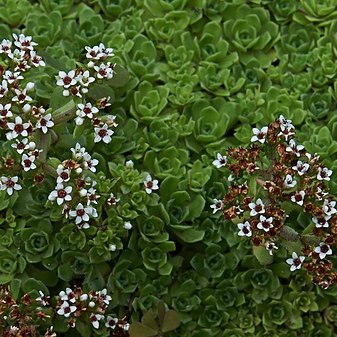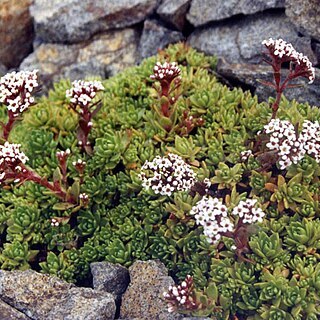Basal leaves congested, subrosulate, up to 3(3·5) x 1 cm., obovate to oblong; cauline leaves up to 1·5 x 0·8 cm., rather smaller than the basal ones, oblong-lanceolate to ovate or sometimes broadly ovate to suborbicular, ± scattered to subimbricate, spreading to erect or reflexed, gradually modified into the bracts of the inflorescence, sometimes all the cauline leaves bract-like, rounded or obtuse to acute at the apex, entire, with a row of contiguous to ± scattered, rigid cilia at the margin (the cilia somewhat thick and ± long or short, white, acute or obtuse, straight or curved and retrorse); all leaves sessile and contracted or not into a broad base, connate for ± 0·5 to ± 2 mm., flattish, green and succulent when fresh, membranous and ± dark coloured on drying, all glabrous on both faces or at least the basal ones hispid or appressed hairy on both sides or only above, the hairs similar to those of stem; internodes longer to subequalling or shorter than the leaves.
Perennial herb, succulent, cushions of rosettes, leaf pairs spirally arranged, old ones remaining on stem, ± 0.15-0.25 m high when flowering. Leaves lanceolate to elliptic or oblong, 6-20 x 2-10 mm, acute, hairy or glabrous with marginal cilia, dorsiventrally flattened but slightly convex below, green tinged red. Inflorescence a round to flat-topped thyrse, 1-several dichasia, pedicellate flowers; peduncle indistinct with leaf-like bracts, shortening upwards. Calyx fleshy, with or without marginal cilia, green tinged red. Corolla tubular, fused 0.4-0.6 mm, white tinged red; lobes oblong-lanceolate, 2.5-3.5 mm long, acute or rounded, recurved. Flowering time Feb.-Apr.
A very polymorphic species in which several varieties, some of them certainly mere variations without taxonomical value, have been distinguished. Most plants which we have seen from the Transvaal, as well as one from Zimbabwe (Goldsmith 11/72) have longer flowers, with relatively longer, narrower sepals and longer anthers, than the syntypes (Zeyher 650 and Burke 401). In addition, they are less rigidly hispid and have sepals either glabrous or with a few papillose hairs or cilia at the apex (the type specimens have sepals long ciliate all round the margin). The rigid indumentum and small flowers of the syntypes of C. setulosa are possibly related to a drier habitat.
Stems up to 22 cm. long (usually shorter, sometimes dwarfed), herbaceous or in stronger plants woody towards the base, erect or ascending or sometimes prostrate and rooting, usually leafy from base to apex or rarely with only a few pairs of leaves, hispid or retrorsely appressed papillose-hairy (hairs usually shorter and thinner than the marginal cilia of the leaves, or papillae short, obtuse).
Calyx (1·5)2-2·75(3) mm. long, 1/2-2/3 as long as corolla, rarely subequalling it; sepals lanceolate or linear-lanceolate, acute to very attenuate, either glabrous except for a terminal papillose hair or with some cilia towards the apex (marginal and dorsal) or with a marginal row of long to short cilia and sometimes also ciliate all along the median line.
Flowers 5-merous in dense cymes forming terminal small subcapitate inflorescences or in corymbs up to 7 cm. in diam., sometimes with small cymes or 1-2 flowers in the axils of the uppermost leaves; inflorescence-branches hispid; pedicels up to 4 mm. long, somewhat thick.
Corolla (2)2·5-4(4·5) mm., white, rarely red; petals 0·75-1·5(2·25) mm. broad, oblong, oblanceolate to obovate, acute to obtuse or rounded at the apex, erect, smooth, without or with a mucro below the apex.
A perennial herb with the stem simple or branched from the base (thus seeming many-stemmed and caespitose), sometimes shortly stoloniferous, forming small dense cushions.
Anthers 0·3-0·5(0·7) mm., subcircular to subrectangular.
Follicles (1·5)2-3(3·5) mm. long (with the styles).
Seeds c. 0·5 mm. long, subcostate-tuberculate.


